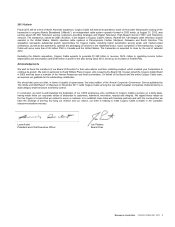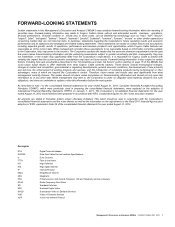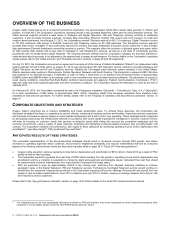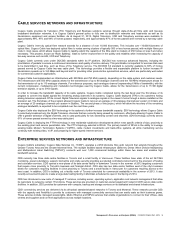Cogeco 2012 Annual Report Download - page 14
Download and view the complete annual report
Please find page 14 of the 2012 Cogeco annual report below. You can navigate through the pages in the report by either clicking on the pages listed below, or by using the keyword search tool below to find specific information within the annual report.Management’s Discussion and Analysis (MD&A) COGECO CABLE INC. 2012 13
When a derivative is designated as the hedging instrument in a hedge of the variability in cash flows attributable to a particular risk associated
with a recognized asset or liability or a highly probable forecast transaction that could affect profit or loss, the effective portion of changes in the
fair value of the derivative is recognized in accumulated other comprehensive income and presented in unrealized gains or losses on cash flow
hedges in equity. The amount recognized in other accumulated comprehensive income is removed and included in profit or loss in the same
period as the hedged cash flows affect profit or loss and in the same line item as the hedged item. Any ineffective portion of changes in the fair
value of the derivative is recognized immediately in profit or loss.
Embedded derivatives
Embedded derivatives are separated from the host contract and accounted for separately if the economic characteristics and risks of the host
contract and the embedded derivative are not closely related. A separate instrument with the same terms as the embedded derivative would
meet the definition of a derivative, and the combined instrument is not measured at fair value through profit or loss. At August 31, 2012 and
2011 and September 1, 2010, there were no significant embedded derivatives or non-financial derivatives that require separate fair value
recognition on the consolidated statements of financial position.
CONTINGENCIES AND COMMITMENTS
The Corporation is subject to various claims and contingencies related to lawsuits, taxes and commitments under contractual and other
commercial obligations. The contractual and other commercial obligations primarily relate to network fees and operating lease agreements for
use of transmission facilities. The Corporation recognizes liabilities for contingencies and commitments when a loss is probable and can be
reasonably estimated based on currently available information. Significant changes in assumptions as to the likelihood and estimates of a loss
could result in the recognition of an additional liability.
RELATED PARTY TRANSACTIONS
Cogeco Cable Inc. is a subsidiary of COGECO Inc., which holds 32.1% of the Corporation’s equity shares, representing 82.6% of the
Corporation’s voting shares. On September 1, 1992, Cogeco Cable Inc. executed a management agreement with COGECO Inc. under which
the parent company agreed to provide certain executive, administrative, legal, regulatory, strategic and financial planning services and
additional services to the Corporation and its subsidiaries (the “Management Agreement”). These services are provided by COGECO Inc.’s
senior executives, including the President and Chief Executive Officer, the Senior Vice President and Chief Financial Officer, the Vice
President Corporate Affairs, the Vice President Chief Legal Officer and Secretary, the Vice President Corporate Development, the Vice
President and Treasurer, the Vice President Public Affairs and Communications and the Vice President Internal Audit. No direct remuneration
is payable to such senior executives by the Corporation. However, the Corporation granted 47,729 stock options (35,800 in 2011) to these
senior executives as executives of Cogeco Cable during fiscal year 2012. During fiscal 2012, the Corporation charged COGECO Inc. an
amount of $324,000 ($276,000 in 2011) with regards to the Corporation’s stock options to these employees.
During fiscal year 2012, the Corporation also granted 11,006 (10,000 in 2011) Incentive Share Units (“ISUs”) to these senior executives as
executives of Cogeco Cable. During fiscal 2012, the Corporation charged COGECO Inc. an amount of $390,000 ($216,000 in 2011) with
regards to the Corporation’s ISUs granted to these employees.
Under the Management Agreement, the Corporation pays monthly fees equal to 2% of its total revenue to COGECO Inc. for the above-
mentioned services. In 1997, the management fee was capped at $7 million per year, subject to annual upward adjustment based on increases
in the Consumer Price Index in Canada. This limit can be increased under certain circumstances upon request to that effect by COGECO Inc.
For fiscal year 2012, the maximum amount of $9.5 million ($9.2 million in 2011) was paid to COGECO Inc. In addition, the Corporation
reimburses COGECO Inc.’s out-of-pocket expenses incurred with respect to services provided to the Corporation under the Management
Agreement.
ADOPTION OF NEW ACCOUNTING STANDARDS
TRANSITION TO IFRS
On January 1, 2011, the Canadian GAAP, as used by publicly accountable enterprises, were fully converged to IFRS. Accordingly, the
Corporation has prepared its first annual consolidated financial statements for the year ended August 31, 2012 in accordance with IFRS. Prior
to the adoption of IFRS, for all periods up to and including the year ended August 31, 2011, the Corporation’s consolidated financial statements
were prepared in accordance with Canadian GAAP. IFRS uses a conceptual framework similar to Canadian GAAP, but there are significant
differences related to recognition, measurement and disclosures. For further details on the Corporation’s transition to IFRS, please refer to
Note 26 of the consolidated financial statements.
The date of the opening financial position under IFRS and the date of transition to IFRS are September 1, 2010. The financial data for fiscal
2011 have therefore been restated. The Corporation is also required to apply IFRS accounting policies retrospectively to determine its opening
statement of financial position, subject to certain exemptions. However, the Corporation is not required to restate figures for periods prior to
September 1, 2010 that were previously prepared in accordance with Canadian GAAP.
























